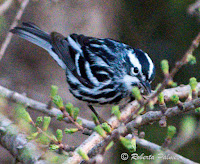BLACK AND WHITE WARBLER
BLACK AND WHITE WARBLER – (Mniotilta varia) – (See images below)
DESCRIPTION: The Black and White Warbler adult breeding male is mainly striped in black and white (as the English name implies). There is a white stripe above the eye. The under parts are also streaked. The under parts are also white without streaks. The bill of this warbler is longer and slightly down-curved. The feet have a long hind claw. Females and juveniles have the same color patterns, although duller. The bird is approximately 11 cm (5 inches) long.
VOICE: https://www.xeno-canto.org/species/Mniotilta-varia
NAME: Warblers are thus called thanks to their generally melodious songs. Latin genus name ‘Mniotilta’ is from ancient Greek and means ‘plucked moss’, due to the erroneous belief that this warbler species was lining its nest with that material (Ernest Choate). Latin species name ‘varia’ means ‘variegated’, in reference to the plumage pattern.
HABITAT: Forests in the summer, and parks, gardens and other city areas, wetlands, orchards and plantations in the winter.
DIET: Forages like a nuthatch, i.e. going up and down tree trunks and branches in search of insects and spiders, helped in this by a long hind claw.
NESTING: The black and white warbler nests on the ground near a tree. The nest is lined with conifer needles, leaves and other plant material, but NOT moss. Generally five creamy eggs are laid, incubated by the female. Both parents feed the chicks. Nest is often parasitized by the Brown-headed Cowbird.
DISTRIBUTION: The breeding range covers much of the southern half of Canada east of the Rockies, and much of the eastern half of the USA. The wintering range extends from Florida and Mexico south to the northern tip of South America.
DISTRIBUTION MAP: https://en.wikipedia.org/wiki/Black-and-white_warbler#/media/File:Mniotilta_varia_map.svg
ON PEI: The black and white warbler breeds on Prince Edward Island and is common on the island in the spring and summer.
CONSERVATION: The population of this warbler species has declined by a third in the last few decades, but it does not yet appear on any list of threatened birds. Some of the factors that may impact its numbers include persistent insecticides in their environment and the fragmentation of forests.
NOTES: This warbler is a rather aggressive species even outside the breeding season, and will chase away intruders from its claimed territory.
SIMILAR SPECIES: Blackpoll Warbler (has a shorter bill and a solid black cap). Black-throated Gray Warbler
REFERENCES: https://www.borealbirds.org/bird/black-and-white-warbler
https://www.mba-aom.ca/jsp/toc.jsp (Maritimes Breeding Bird Atlas)
https://www.audubon.org/field-guide/bird/black-and-white-warbler
American Bird Conservancy (Black and White Warbler)
https://en.wikipedia.org/wiki/Black-and-white_warbler
https://www.allaboutbirds.org/guide/Black-and-white_Warbler/id
https://nature.mdc.mo.gov/discover-nature/field-guide/black-and-white-warbler (Missouri Department of Conservation)
DESCRIPTION: The Black and White Warbler adult breeding male is mainly striped in black and white (as the English name implies). There is a white stripe above the eye. The under parts are also streaked. The under parts are also white without streaks. The bill of this warbler is longer and slightly down-curved. The feet have a long hind claw. Females and juveniles have the same color patterns, although duller. The bird is approximately 11 cm (5 inches) long.
VOICE: https://www.xeno-canto.org/species/Mniotilta-varia
NAME: Warblers are thus called thanks to their generally melodious songs. Latin genus name ‘Mniotilta’ is from ancient Greek and means ‘plucked moss’, due to the erroneous belief that this warbler species was lining its nest with that material (Ernest Choate). Latin species name ‘varia’ means ‘variegated’, in reference to the plumage pattern.
HABITAT: Forests in the summer, and parks, gardens and other city areas, wetlands, orchards and plantations in the winter.
DIET: Forages like a nuthatch, i.e. going up and down tree trunks and branches in search of insects and spiders, helped in this by a long hind claw.
NESTING: The black and white warbler nests on the ground near a tree. The nest is lined with conifer needles, leaves and other plant material, but NOT moss. Generally five creamy eggs are laid, incubated by the female. Both parents feed the chicks. Nest is often parasitized by the Brown-headed Cowbird.
DISTRIBUTION: The breeding range covers much of the southern half of Canada east of the Rockies, and much of the eastern half of the USA. The wintering range extends from Florida and Mexico south to the northern tip of South America.
DISTRIBUTION MAP: https://en.wikipedia.org/wiki/Black-and-white_warbler#/media/File:Mniotilta_varia_map.svg
ON PEI: The black and white warbler breeds on Prince Edward Island and is common on the island in the spring and summer.
CONSERVATION: The population of this warbler species has declined by a third in the last few decades, but it does not yet appear on any list of threatened birds. Some of the factors that may impact its numbers include persistent insecticides in their environment and the fragmentation of forests.
NOTES: This warbler is a rather aggressive species even outside the breeding season, and will chase away intruders from its claimed territory.
SIMILAR SPECIES: Blackpoll Warbler (has a shorter bill and a solid black cap). Black-throated Gray Warbler
REFERENCES: https://www.borealbirds.org/bird/black-and-white-warbler
https://www.mba-aom.ca/jsp/toc.jsp (Maritimes Breeding Bird Atlas)
https://www.audubon.org/field-guide/bird/black-and-white-warbler
American Bird Conservancy (Black and White Warbler)
https://en.wikipedia.org/wiki/Black-and-white_warbler
https://www.allaboutbirds.org/guide/Black-and-white_Warbler/id
https://nature.mdc.mo.gov/discover-nature/field-guide/black-and-white-warbler (Missouri Department of Conservation)
 |
| Black and white warbler, Roberta Palmer |
 |
| Black and white warbler, Kathy McCormack |
 |
| Black and white warbler, Roberta Palmer |
 |
| Black and white warbler, QC, by Cephas |